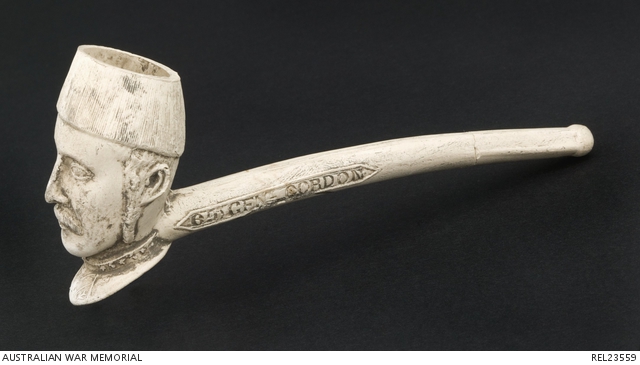| Place | Africa: Sudan |
|---|---|
| Accession Number | REL23559 |
| Collection type | Heraldry |
| Object type | Heraldry |
| Physical description | Clay |
| Maker |
Unknown |
| Place made | United Kingdom: England |
| Date made | c 1880s-1890s |
Souvenir clay pipe depicting General Charles Gordon


Clay pipe with the bowl in the shape of the head of General Charles 'Chinese' Gordon, wearing a Pasha hat. The tapered pipe stem is broken an inch from the lip and has been repaired. On one side of the stem, near the bowl it is impressed 'GEN GORDON', and on the other side '65 GEN GORDON'. The underside of the stem is stamped 'MADE IN ENGLAND' in black ink.
General Charles ‘Chinese’ Gordon was born at Woolwich, London on 28 January 1833, the son of Major General Henry William Gordon and Elizabeth Enderby. At 15 he entered the Royal Military Academy at Woolwich. In 1852 he was commissioned as a second lieutenant. He was promoted to full lieutenant in 1854. Gordon e served in the Crimean War in 1854, and in China, where he took command of the ‘Ever Victorious Army’ in 1863. He was promoted to the rank of titu – one of the highest ranks in the Chinese Army by the Chinese Emperor. The British promoted him to lieutenant colonel and he was made a Companion of the Order of the Bath. He later served in North Africa, including Egypt. In the early 1880s the British-backed Egyptian regime in the Sudan was threatened by an indigenous rebellion under the leadership of Muhammed Ahmed, known to his followers as 'the Mahdi'. In 1883 the Egyptian government, with British acquiescence, sent an army south to crush the revolt. Instead of destroying the Mahdi's forces, the Egyptians were soundly defeated, leaving their government with the problem of extricating the survivors. The difficulties of evacuating their forces in the face of a hostile enemy quickly became apparent, and the British were persuaded to send Gordon, to consider the means by which the Egyptian troops could be safely withdrawn. Disregarding his instructions, Gordon sought instead to delay the evacuation and defeat the Mahdi; like the Egyptians, Gordon failed and found himself besieged in Khartoum. The popular general's predicament stirred public opinion in England, leading to demands for an expeditionary force to be dispatched to his rescue. The relief force was sent from Cairo in September 1884, but it did not arrive in Khartoum until 28 January 1885, two days after Gordon had been killed, on 26 January. He had been beheaded and his head displayed on a pike by the Mahdi’s soldiers. Even before his death, Gordon was a figure of heroic proportions in England, and his exploits were well known throughout the British Empire. When his death became known, it caused high feeling amongst the British public. Many souvenirs commemorating Gordon were made and the painting ‘General Gordon's Last Stand’ by George William Joy, showed a romantic and popular interpretation of Gordon’s death – even though the exact circumstances of his death were unknown. This clay pipe is one souvenir made to remember General Gordon. The pipe has been made from porcelain forming techniques known as slip and poured into a mould, creating a detailed portrait bust of Gordon. These types of clay pipes are generally porous and impart unwanted flavours when smoked. Most were unglazed and burned hot when used. Clay pipes were considered disposable items. The stems were fragile and often broke, and would be thrown in the rubbish. This pipe’s stem, too, has broken at some point, but the pipe has been repaired rather then thrown out, probably to keep as a souvenir, rather than for continued use as a pipe.